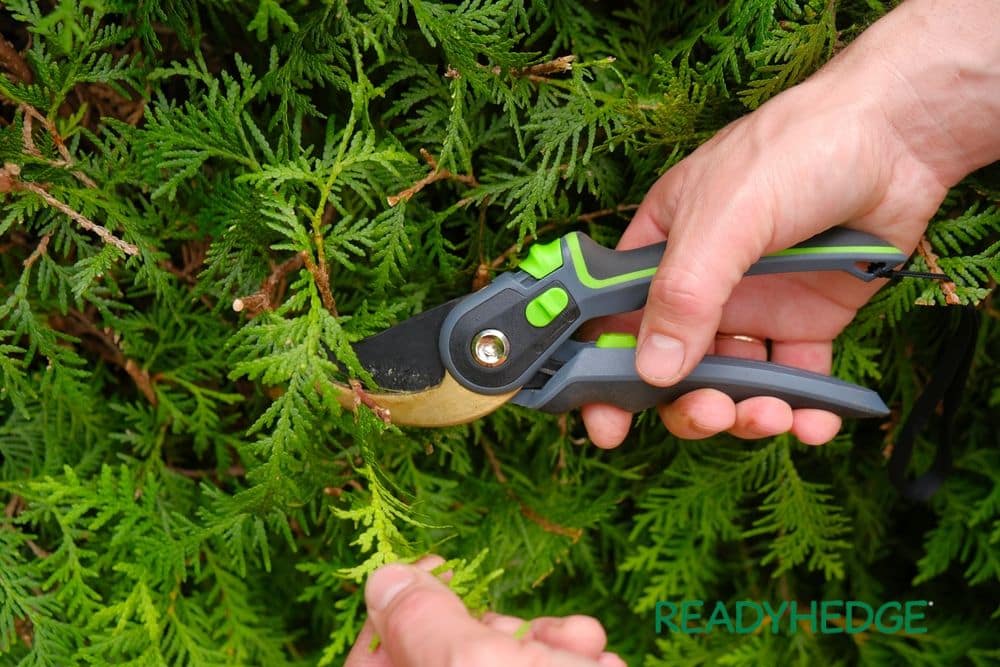
by Simon Williamson | Jul 8, 2023 | News
With the arrival of summer’s warm weather, it’s the perfect opportunity to enhance our outdoor living spaces. An excellent starting point is to enhance the natural charm of your garden, and hedge trimming is a valuable technique to achieve this. Mastering the art of pruning during the summertime may seem daunting at first, but fear not! Our comprehensive guide will demonstrate just how effortless it can be with the essential knowledge of how to hedge trimming in summer. Within these tips, you’ll discover everything necessary to embark on your quest of unveiling your garden’s magnificence through expert hedge trimming.
Timing is Key: The Perfect Time of Year for Hedge Trimming
Trimming your hedge during the summer season can work wonders for its overall health and appearance. Early summer, after the spring growth spurt, is an ideal time to start cutting the hedge. This timing allows for the removal of any damaged or dead branches while encouraging fresh, vibrant growth for the rest of the season.
Informal Hedging: Embrace the Beauty of Natural Shape
One of the best practices for hedge trimming in summer is maintaining a natural shape. This involves working with the hedge’s existing contour and allowing it to retain its authenticity. Hand-held shears are perfect for informal hedging, as they offer precision and allow you to sculpt your hedge with care.
Tools for the Job: Mastering the Art of Hedge Trimming
To achieve pristine results, invest in high-quality tools designed for hedge trimming. Hand-held shears are excellent for small hedges or touch-ups. For larger hedges, a hedge trimmer is a time-saving and efficient option. Consider the size and type of your hedge before choosing the right tool for the job.
Taming the Giants: Conquering Tall Hedges
Trimming tall hedges can be a daunting task, but with the right techniques, it becomes a breeze. Always use a stable ladder or an extendable tool when working on tall hedges. Start by trimming the side of the hedge, carefully following its natural shape. Once the sides are complete, trim the top of the hedge, ensuring a uniform height.
Tips for Pruning Flowering Hedges
Flowering hedges add a touch of elegance to any garden, but pruning them requires a delicate touch. To avoid sacrificing the blooms, prune these hedges immediately after they finish flowering. This practice ensures you don’t inadvertently remove the buds forming for the next season.
Art of Formal Hedges: Turning Your Garden into a Sculpture
Formal hedges require precise and well-defined shapes to create a sense of order and elegance in your garden. A hedge trimmer is the tool of choice for these hedges, as it allows for straight lines and smooth edges. Be patient and take your time, as perfection in formal hedging is an art in itself.
The Top Tip for Hedge Trimming in Summer: Stay Hydrated
Amid the summer heat, it’s essential to take care of yourself as well. Hedge trimming can be physically demanding, so remember to stay hydrated throughout the process. Take breaks, seek shade, and wear appropriate clothing to protect yourself from the sun.
Final Thought
Hedge trimming in summer is an essential aspect of garden maintenance that reaps numerous rewards. By choosing the right time of year, embracing the natural shape of your hedges, and utilizing the appropriate tools, you can turn hedge trimming into an art form. Whether it’s tall hedges, flowering beauties, or formal masterpieces, nurturing your hedges will create a stunning backdrop for your outdoor sanctuary. So, don your gardening gloves, pick up your hedge trimmer or hand-held shears, and embark on a journey to transform your garden into a flourishing haven of beauty.
Frequently Asked Questions (FAQ)
When is the best time to start hedge trimming in summer?
Early summer, after the spring growth spurt, is the ideal time to begin trimming your hedges in summer. This allows for the removal of any damaged or dead branches while promoting healthy growth throughout the season.
Can I trim my hedge in early spring instead of summer?
While early spring is a suitable time for some maintenance tasks, it is generally not recommended for extensive hedge trimming. Trimming hedges in early spring may disrupt the growth cycle and potentially harm the plant. It’s best to wait until summer for more significant trimming.
What tools do I need for hedge trimming in summer?
– The tools you’ll need depend on the size and type of your hedges. Hand-held shears are ideal for precise trimming and shaping, while hedge trimmers are more efficient for larger hedges. Other useful tools may include loppers for thicker branches and a stable ladder for tall hedges.
How often should I trim my hedges during the summer?
The frequency of hedge trimming depends on the growth rate of your particular hedge. As a general guideline, trimming every 4-6 weeks during the active growth period in summer should help maintain a neat appearance. However, it’s important to monitor your hedges and trim them as needed to prevent excessive growth.
Can I trim flowering hedges in summer?
It’s generally best to trim flowering hedges immediately after they finish blooming. This timing allows the hedge to set new buds for the following season while still maintaining its beauty. Trimming too late in summer may result in cutting off the developing buds and reducing next year’s blooms.
Are there any safety precautions to consider while hedge trimming?
Safety should always be a priority when working with tools and hedges. Wear appropriate protective gear, such as gloves and safety glasses, to prevent injuries. Ensure that the tools you use are in good working condition, and follow the manufacturer’s instructions. Be cautious when using ladders and always maintain stability and balance.
Can I shape my hedges into different forms, like animals or geometric shapes?
While it is possible to create more intricate shapes with hedges, it requires advanced skills and regular maintenance. Geometric shapes and topiaries often require extensive pruning and shaping. It’s advisable to consult a professional or a skilled gardener if you’re interested in creating elaborate designs with your hedges.
Remember, hedge trimming in summer is an ongoing process that requires care and attention. By following the appropriate techniques, using the right tools, and considering the specific needs of your hedges, you can achieve stunning results and enjoy a beautiful, well-maintained garden all season long.

by Matthew Kemble | Jun 13, 2023 | News
Looking for some creative solutions to spruce up your yard? Garden hedges are a great way to add color, texture, and height to your outdoor space. With the right ideas for garden hedges, you can make your backyard the envy of all your neighbors! From evergreen foundation plantings to colorful flowering shrubs, there are many great ideas out there for creating amazing garden hedges. In this blog post, we will explore some of those options and provide you with the tips and tricks you need for success. So if you’re ready to get creative with garden hedges- let’s get started!
15 Ideas for Garden Hedge – Get Creative, Enjoy Desired Outlook
Gardens are always something personal that everybody wants to make it more beautiful and most of them take care of it as their child. So, if a garden is your peaceful place and you want to make it more and more beautiful with the help of its hedge, then as a garden hedge I am here for your help. I am giving you 15 creative and unique ideas for garden hedge.
1. Nurture a Low-maintenance Hedge with Evergreen Shrubs like Boxwood or Yew
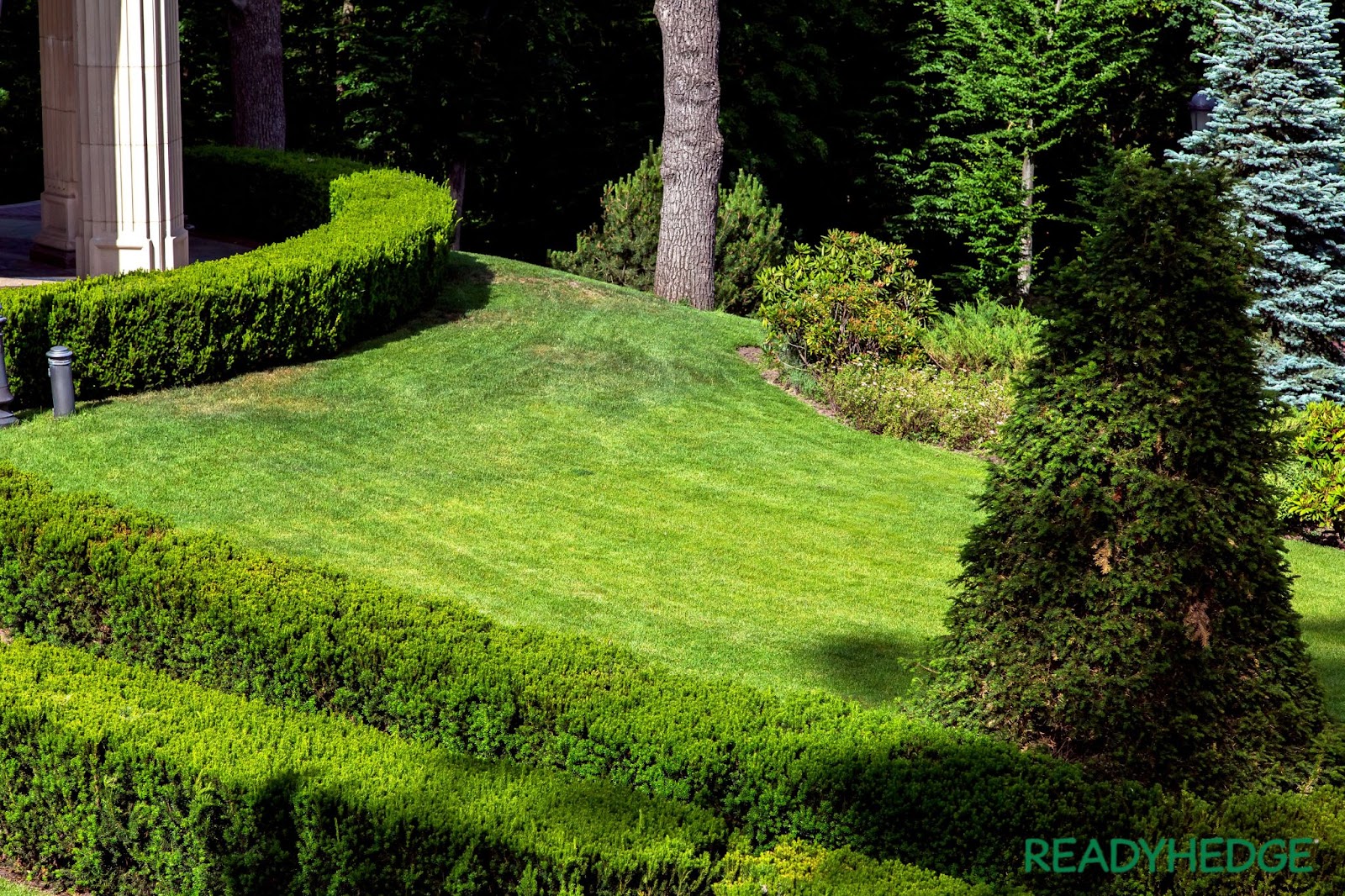
Evergreen shrubs like boxwood and yew are great choices for hedges because they require minimal maintenance. These plants stay green year-round, so you don’t have to worry about constantly pruning them or replacing dead branches with new ones. Boxwood is an ideal choice if you are looking for a low-maintenance hedge. It can be trimmed into various shapes and sizes, plus it is very tolerant of cold temperatures. On the other hand, yew hedges provide an elegant look with its pointed foliage and dark green color that will not fade in winter. Both boxwood and yew can require up to three years for full growth, so patience is key when establishing these plants as hedges.
2. Plant Flowering Hedges to Attract Bright Vibrant Colors to Your Garden
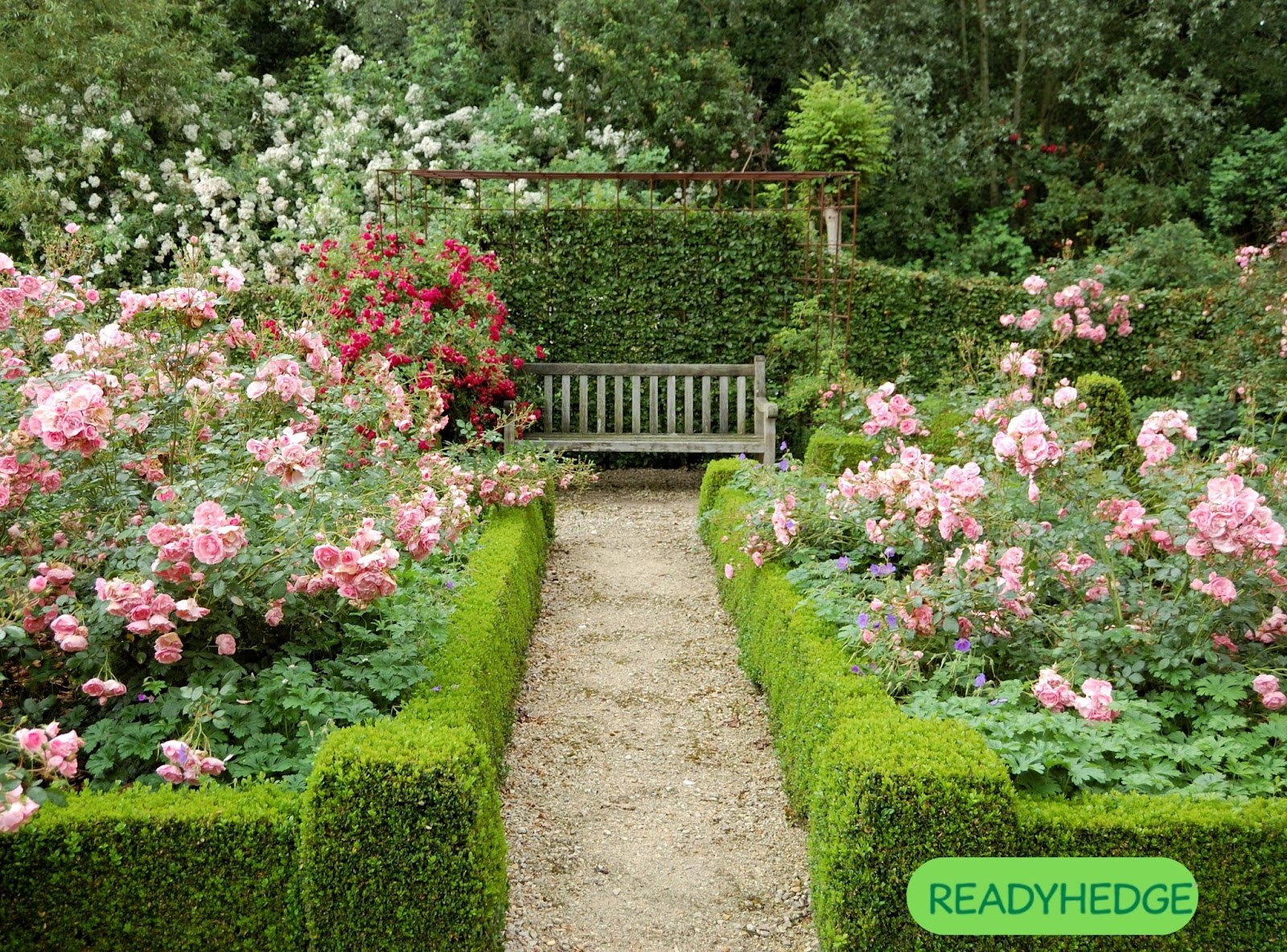
If you are looking to add some brightness and color to your garden, then flowering hedges are the way to go. There are lots of varieties of flowering shrubs that can be used for hedging. Some popular options include azaleas, hydrangeas, and rhododendrons. Azaleas come in many colors such as pink, white, or red and they produce beautiful blooms throughout springtime. Similarly, hydrangea bushes feature big clusters of colorful flowers from summer into fall while rhododendrons bring a bright pop of pink or purple in early springtime. Planting these flowering shrubs will attract butterflies and other beneficial pollinators to your garden!
3. Choose a Tough Plant Such as Pyracantha for Spiky Security and Protection from Wind
For an added layer of security and protection from the wind, consider planting a tough plant such as Pyracantha. This evergreen shrub grows quickly and is often used for hedging because it has spiky branches that can deter intruders. It also produces white flowers in springtime followed by bright orange berries in fall. Pyracantha can be kept dense with regular trimming or left to grow into its own wild shape- either way you are sure to get an attractive and unique hedge that will provide security for your outdoor space.
4. Plant Native Species That Can Thrive in Your Region’s Climate and Soil Type
If you want to be sure your garden hedge will thrive for years to come- choose native species. Native plants are adapted to the climate and soil type of your region, so they require minimal maintenance and are more likely to survive through tough weather conditions. Look up what types of hedges grow best in your area or speak with a local nursery expert for advice on the best option for you.
No matter what ideas you have for garden hedges, it is important that each plant gets adequate sunlight and water as well as proper pruning when necessary. With these tips in mind, you can easily create amazing looking garden hedges that will enhance the beauty of your outdoor space!
5. Heavenly Scents: Enhance Your Garden with Fragrant Hedges
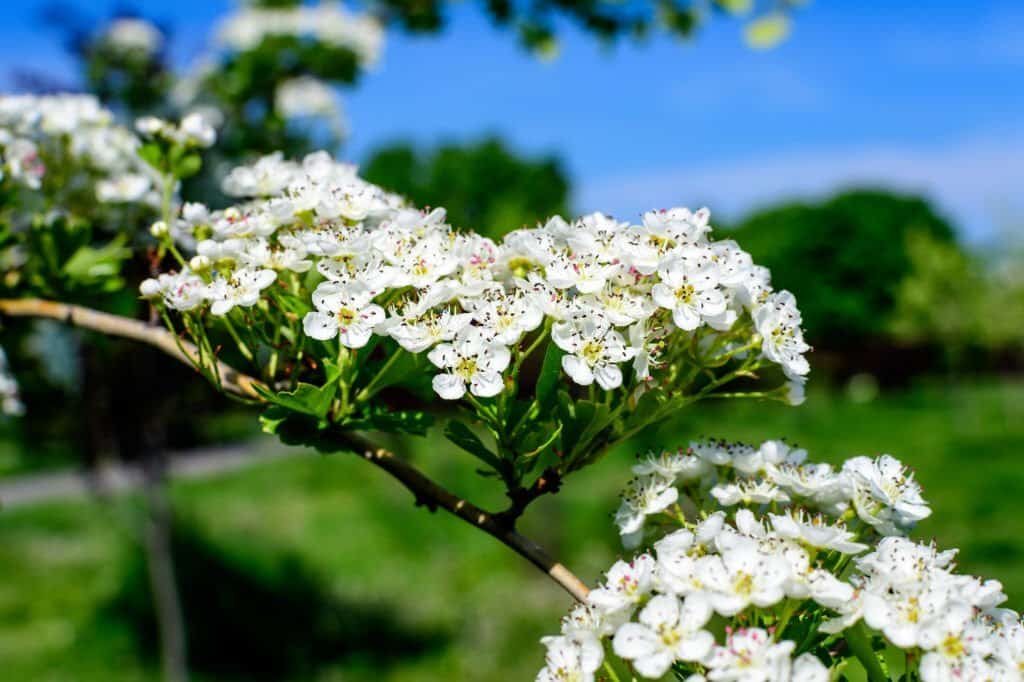
Create a fragrant garden hedge by incorporating aromatic plants such as lavender, rosemary, or jasmine. Not only will they provide a beautiful visual display, but they will also emit delightful scents, enhancing your garden experience.
6. Create Texture and Diversity with Mixed Hedges
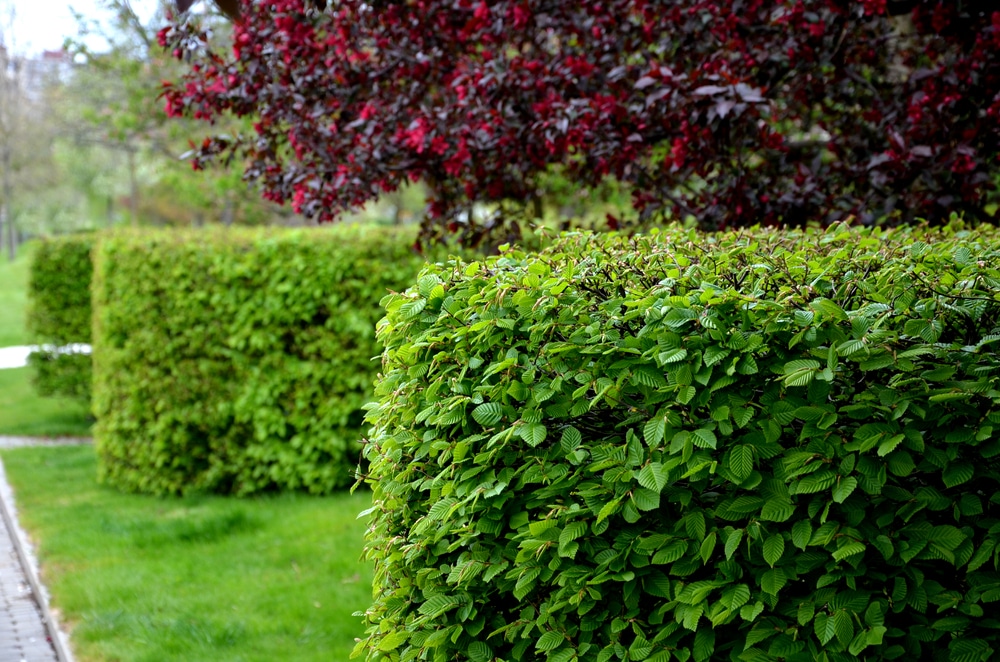
Opt for a mixed hedge that combines different types of plants, such as evergreen shrubs, flowering plants, and ornamental grasses. This diversity will add texture and visual interest to your garden while attracting a variety of beneficial insects and birds.
7. Unique Hedge Shapes for a Garden with Character
Experiment with different hedge shapes to add uniqueness and creativity to your garden. Instead of the traditional straight-line hedge, consider creating curved or wavy designs. You can even explore topiary techniques to sculpt your hedges into intricate shapes like animals or geometric patterns.
8. Edible Delights: Fruit-Bearing Hedges for a Bountiful Garden
Incorporate edible hedges into your garden, such as fruit-bearing shrubs like blueberries or raspberries. Not only will these hedges provide privacy and beauty, but they will also yield delicious, homegrown produce for you to enjoy.
9. Privacy and Style with Hedge Fences
Install a hedge fence, which combines the functionality of a traditional hedge with the structure of a fence. Using taller shrubs or trees, this type of hedge can provide both privacy and security while maintaining a natural and aesthetically pleasing appearance.
10. Discover the Joy of Sensory Hedges in Your Garden

Create a sensory hedge by selecting plants that engage multiple senses. For example, include plants with different textures like fuzzy leaves or rough bark, plants with interesting colors, and those that make pleasant sounds when the wind rustles through them, such as ornamental grasses.
Consider using evergreen climbers or vining plants, such as ivy or clematis, to cover walls or fences and create a living hedge. These climbers will not only add greenery and privacy but also introduce vertical interest and a touch of elegance to your garden.
12. Define Borders and Pathways with Compact Hedges
Incorporate low-growing or dwarf hedges to define borders or pathways within your garden. These compact hedges can guide visitors through your outdoor space while adding structure and organization to the overall design.
13. Integrating Hedges with Water Features and Seating Areas
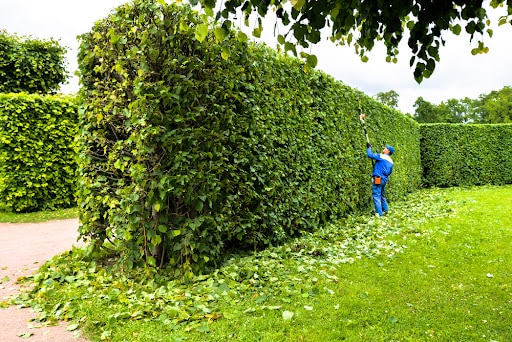
Combine your hedge with other garden elements, such as a water feature or seating area, to create a harmonious and inviting atmosphere. By integrating your hedge with other focal points, you can establish a cohesive and visually appealing garden design.
14. Consider an Artificial Option for Minimal Maintenance and All-weather Protection
If you are looking for an even easier solution to garden hedges, then consider artificial options. Artificial plants and hedges can provide a great look at minimal maintenance. Plus they are all-weather resistant so you don’t have to worry about them wilting or dying in extreme temperatures. Whether you choose a real or artificial hedge, your outdoor space will be looking great in no time!
15. Add Some Structural Definition to Your Yard by Utilizing Garden Trellises
Garden trellises are a great way to give your outdoor space some structure and definition. You can use them to create living walls or even build a canopy over an outdoor seating area. With the right plants, garden trellises can also be used as hedges- adding texture and color to your yard while providing more privacy than traditional fencing. Ivy is one of the best options for this type of hedge because it grows quickly and can be trained into nearly any shape you desire!
Final Thought
No matter what ideas you have for garden hedges, there is a solution that will fit your needs and spruce up your yard. From evergreen foundation plantings to flowering shrubs, artificial options or trellises- there are plenty of creative solutions to choose from! Be sure to consider the climate and soil type in your region when selecting plants so they can thrive long-term. With some careful planning and research, you can create an amazing looking garden hedge that will make all of your neighbors jealous!
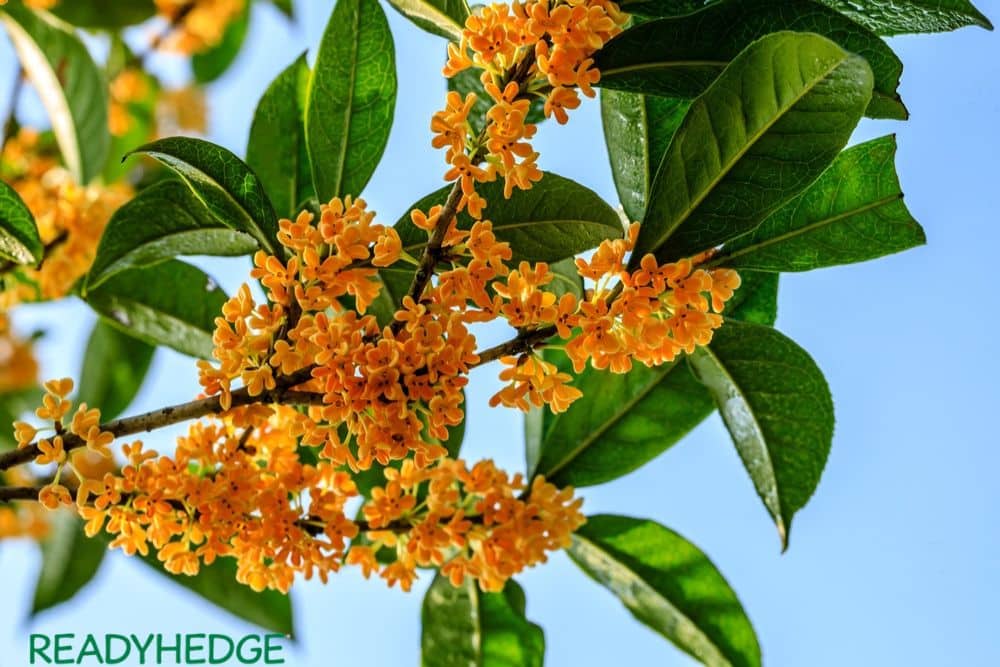
by Matthew Kemble | Jun 13, 2023 | News
Welcome to the captivating world of Osmanthus, a flowering plant renowned for its exquisite fragrance and timeless beauty. In this article, we will delve deeper into the realm of Osmanthus, providing you with detailed insights on its blooming season, appearance, optimal growing conditions, landscaping potential, cultural significance, and maintenance tips. Prepare to be enchanted by the allure of Osmanthus, as we explore its every facet.
Meet the Osmanthus
Osmanthus, scientifically known as Osmanthus fragrans, is a versatile evergreen shrub or small tree belonging to the Oleaceae family. Originating from East Asia, this elegant plant encompasses various species, including Osmanthus fragrans, Osmanthus heterophyllus, and Osmanthus delavayi, each possessing unique characteristics and charm.
The Blooming Season: When Does Osmanthus Bloom
The blooming season of Osmanthus is a much-awaited spectacle for garden enthusiasts. Depending on the specific species and prevailing climate conditions, Osmanthus generally bursts into bloom during late autumn or early winter. This timing adds a touch of enchantment to colder months, infusing gardens and landscapes with its delightful fragrance and ethereal beauty.
A Closer Look at Osmanthus Blooms
The blossoms of Osmanthus possess an innate charm that captivates the observer. Delicate and small, these flowers come in various shades, ranging from creamy white to vibrant yellow, with a few species even displaying hints of orange. Each blossom consists of four petals, intricately arranged in clusters or racemes, further enhancing their visual appeal and creating an awe-inspiring display.
An Aroma Like No Other
The captivating fragrance emitted by Osmanthus flowers is nothing short of magical. Described as a delightful blend of fruity, floral, and apricot-like notes, its scent pervades the air, offering an invigorating and uplifting experience. This extraordinary aroma has earned Osmanthus its well-deserved nickname, “Sweet Olive,” adding to its allure and desirability.
Optimal Conditions for Growth
Osmanthus is generally a hardy plant that thrives in moderate climates. It prefers a location with full to partial sunlight and well-drained soil. While it can adapt to a wide range of soil types, Osmanthus appreciates slightly acidic to neutral pH levels. Adequate watering and occasional fertilization contribute to the plant’s overall health, promoting vigorous growth and abundant blooms.
Landscaping with Osmanthus
The versatility of Osmanthus makes it an excellent choice for various landscaping purposes. Its elegant appearance, coupled with its intoxicating fragrance, makes it a popular selection as a standalone specimen, privacy hedge, or even as an espalier against a wall. Additionally, the compact growth habit and glossy foliage of Osmanthus lend themselves well to topiary and bonsai creations, adding artistic flair to any garden or outdoor space.
The Cultural Significance
Osmanthus holds profound cultural significance in different regions. In Chinese culture, it symbolizes love, romance, and fidelity, often used in traditional wedding ceremonies and moon festivals. Similarly, in Japan, Osmanthus is considered a harbinger of prosperity, happiness, and luck, making it an integral part of celebrations and auspicious events.
Pruning and Maintenance
To maintain a healthy and well-shaped Osmanthus plant, regular pruning is essential. After the blooming season, prune to remove any dead or damaged branches, promoting new growth and ensuring a more robust blooming period in the following year. This practice also allows you to shape the plant according to your preferences, enhancing its aesthetic appeal.
Final Thought
Prepare to immerse yourself in the enchanting realm of Osmanthus, where fragrance meets beauty. From its delicate blossoms to its intoxicating aroma, Osmanthus offers a sensory experience that captivates all who encounter it. By understanding its blooming season, appearance, optimal growing conditions, landscaping potential, cultural significance, and maintenance requirements, you can embrace Osmanthus as a cherished addition to your garden. So, embark on this fragrant journey and let the allure of Osmanthus infuse your surroundings with its timeless charm.
Frequently Asked Questions (FAQ)
Can Osmanthus be grown in different climates?
Osmanthus is adaptable to a wide range of climates, but it generally thrives in moderate climatic conditions. It can tolerate both hot summers and mild winters, making it suitable for various regions.
Does Osmanthus require special care or maintenance?
Osmanthus is a relatively low-maintenance plant. It appreciates well-drained soil, adequate watering, and occasional fertilization. Regular pruning after the blooming season helps maintain its shape and promotes healthier growth.
How long does the blooming period of Osmanthus last?
The blooming period varies depending on the species and local climate. Generally, Osmanthus blooms persist for several weeks, allowing ample time to relish their captivating beauty and fragrance.
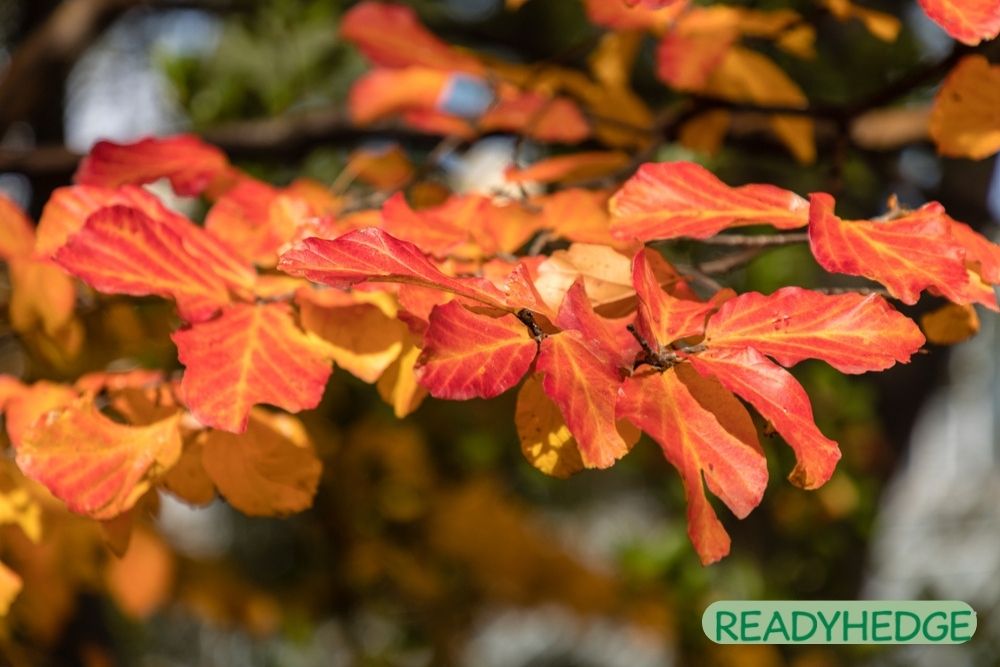
by Matthew Kemble | Jun 12, 2023 | News
Are you looking for a unique and exotic tree to add to your garden? Look no further than the rare Parrotia persica Vanessa, a magnificent species boasting beautiful bark and foliage. Have you ever heard of the majestic Parrotia Persica Vanessa? If you haven’t, now is your chance to learn more about this rare and exquisite species! In this blog post, we will explore the characteristics and history of this amazing Parrotia persica Vanessa tree.
Unveiling the Beauty
With a closer look at the Parrotia persica Vanessa, it’s impossible to miss its stunning display of colors. In early spring, as the tree emerges from its dormant phase, a breathtaking transformation takes place. Its branches become adorned with delicate crimson and scarlet flowers, offering a vibrant spectacle that is truly awe-inspiring. As the seasons progress, the foliage evolves, showcasing a splendid array of rich green hues in summer, transitioning into a glorious mix of fiery red, yellow, and orange during autumn.
Origin and History
The Parrotia persica Vanessa, commonly known as Persian Ironwood or Vanessa Tree, originates from the forests of Iran, Northern Turkey, and the Caucasus region. Named after the German naturalist Friedrich Parrot, this tree species has a storied history that dates back centuries. Revered for its ornamental value and exceptional resilience, it has become a cherished addition to botanical collections and urban landscapes around the world.
Iconic Features
Till now, you must have fallen in love with this parrotia persica vanessa and now it’s time to know more in depth about it. So, get ready to discover more about this wonder piece of plant.
Distinctive Bark
One of the most striking attributes of the Parrotia persica Vanessa is its bark. Revealing a tapestry of colors, ranging from creamy white and gray to mottled patches of brown, it adds texture and intrigue to its aesthetic appeal. The peeling bark of mature specimens reveals layers of contrasting hues, creating a visual spectacle that truly sets this tree apart.
Mesmerizing Leaves
The foliage of the Parrotia persica Vanessa is equally captivating. Its elliptical-shaped leaves feature serrated edges, contributing to its unique charm. During spring and summer, the leaves provide a lush and dense canopy, casting a cooling shade. As autumn approaches, they transform into a mesmerizing palette of warm tones, evoking a sense of enchantment.
Growing Conditions
There are some conditions on which the growth of this plant depends and as an expert I suggest you understand about them if you want to have this plant in your home.
Climate
The Parrotia persica Vanessa thrives in temperate climates, particularly those with distinct seasons. It adapts well to a variety of zones, ranging from USDA hardiness zones 5 to 8, making it suitable for a wide range of regions.
Sunlight and Soil
Vanessa prefers full sun to partial shade, as it helps enhance its vibrant foliage and flower colors. It can tolerate various soil types but thrives in well-drained soil that retains moisture.
Landscaping and Maintenance
The Parrotia persica Vanessa is a versatile tree that can be a focal point in both residential and public landscapes. Its compact size and rounded canopy make it an excellent choice for urban gardens, parks, and even large containers. Pruning is generally minimal, with occasional removal of dead or crossing branches to maintain its health and shape.
Conservation Efforts
Due to its rarity, the Parrotia persica Vanessa is classified as a threatened species in its native habitat. To preserve its genetic diversity and protect it from extinction, various organizations and botanical institutions work diligently to cultivate and propagate this remarkable tree.
Conclusion
In the realm of botanical wonders, the Parrotia persica Vanessa stands as a true masterpiece. From its origins in Iran and Turkey to its introduction in landscapes worldwide, this rare tree species showcases nature’s artistry at its finest. Its adaptability to diverse climates and its versatility in landscaping make it a prized addition to gardens, parks, and urban spaces. As we appreciate the beauty of the Parrotia persica Vanessa, let us also recognize the importance of conservation efforts to ensure the preservation of this remarkable species for future generations. Embrace the allure of the Parrotia persica Vanessa and witness firsthand the extraordinary beauty that nature has to offer.
FAQ
Can I grow the Parrotia persica Vanessa in a small urban gard?
Yes, the Parrotia persica Vanessa is well-suited for small urban gardens due to its compact size and rounded canopy. It can serve as a focal point, adding beauty and interest to limited spaces.
How do I care it in terms of watering and fertilization?
The Parrotia persica Vanessa generally requires moderate watering, particularly during dry periods. It is important to ensure the soil is well-drained but retains moisture. As for fertilization, applying a balanced slow-release fertilizer in early spring can help promote healthy growth.
Can I plant the Parrotia persica Vanessa in a container on my patio?
Yes, the Parrotia persica Vanessa can be grown successfully in containers on patios or balconies. Just ensure the container is large enough to accommodate its root system and use a well-draining potting mix.
Is the Parrotia persica Vanessa suitable for regions with mild winters?
Yes, the Parrotia persica Vanessa is adaptable to regions with mild winters. It can tolerate a range of temperatures but prefers temperate climates with distinct seasons.
Can I propagate the Parrotia persica Vanessa from seeds or cuttings?
Propagating the Parrotia persica Vanessa from seeds can be challenging due to its complex germination requirements. However, it is possible to propagate the tree through hardwood cuttings taken in late winter or early spring.
Does the Parrotia persica Vanessa require any special pruning techniques?
The Parrotia persica Vanessa generally requires minimal pruning. However, it is advisable to remove any dead or crossing branches as needed to maintain its health and aesthetic shape. Pruning should ideally be done during late winter or early spring.
Does the Parrotia persica Vanessa have any disease or pest concerns?
The Parrotia persica Vanessa is relatively resistant to diseases and pests. However, occasional issues with aphids or scale insects may arise. Regular monitoring and appropriate pest management practices can help address these challenges effectively.
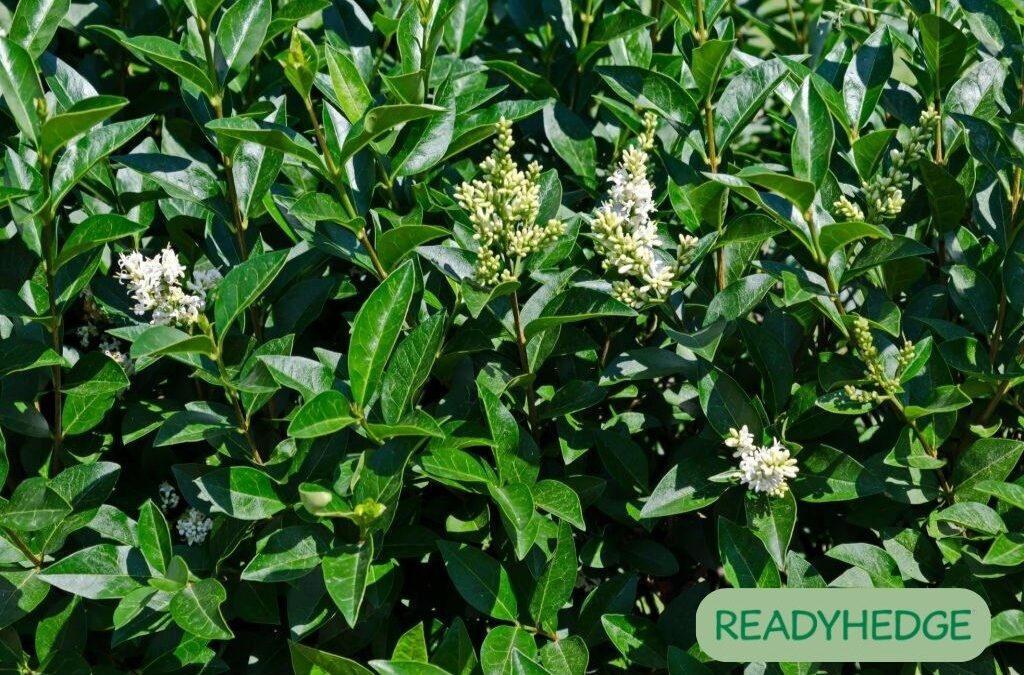
by Matthew Kemble | Jun 12, 2023 | News
Prepare to be mesmerized! osmanthus x burkwoodii bursts onto the scene with its stunning, captivating beauty. Let your senses be delighted by the captivating beauty of the osmanthus x burkwoodii! This enigmatic evergreen shrub has truly earned its place in our hearts and gardens due to its stunning display of fragrant white-yellow flowers that can bloom for months. It’s a perfect choice for anyone looking to add unique color, texture, and fragrance to any outdoor space. Osmanthus x burkwoodii is the ideal plant to create an unforgettable atmosphere in any garden.
Overview of the Osmanthus x Burkwoodii Plant
The Osmanthus x Burkwoodii is a hybrid evergreen shrub that can reach up to 15 feet in height and width. Its glossy leaves range from deep green to olive-brown, providing the perfect backdrop for its sweetly fragrant white flowers that bloom from late winter through early spring. The blooms have an intense aroma reminiscent of apricots or peaches, making it a great choice for gardens with plenty of sun exposure. The flowers also attract butterflies and other pollinators, helping to add further beauty and life into the garden space!
Benefits of Planting an Osmanthus x Burkwoodii
Osmanthus x Burkwoodii is the ideal plant for any garden, offering plenty of advantages and benefits. It requires very little maintenance, so you don’t have to worry about spending too much time tending to it. Additionally, the Osmanthus x Burkwoodii is quite drought-tolerant and can handle a wide range of soil conditions. Its blooms offer plenty of color and fragrance, adding an alluring ambiance to any garden space. Finally, its dense foliage provides year-round privacy for you and your family – perfect for those looking for a bit more seclusion in their outdoor areas!
How to Care for an Osmanthus x Burkwoodii
Caring for the Osmanthus x Burkwoodii is quite simple. It thrives in full sun or partial shade and prefers moist, well-drained soil. While it is drought tolerant, regular watering will help ensure that your plant remains healthy and vibrant throughout the season. Pruning should be done towards the end of winter to promote more blooms in springtime. Finally, fertilizing once a year with an organic fertilizer or compost can also help keep your plant looking its best!
How to Grow an Osmanthus x Burkwoodii from Seeds
If you’re feeling adventurous, try growing your own Osmanthus x Burkwoodii from seed! It’s a great way to add this stunning shrub to your garden without having to buy one. To get started, you’ll need fresh seeds that have been stored in the refrigerator for at least two weeks prior to planting. Soak the seeds overnight before sowing them about ¼ inch deep into well-draining soil and keep them moist until they germinate. You can expect your Osmanthus x Burkwoodii to bloom within two years.
Suitable Soil and Position for Maximum Growth
Osmanthus x burkwoodii prefers moist, well-drained soil and full sun to partial shade. It is fairly drought tolerant, but regular watering will help ensure healthy growth and plenty of blooms in the springtime. Planting it in an area that receives at least six hours of sunlight a day should be sufficient for optimum growth. Additionally, make sure to keep your plant away from strong winds as this can damage its foliage.
Best Practices on Pruning and Maintenance for Healthy Plants
Pruning your Osmanthus x Burkwoodii is important for promoting healthy growth and abundant blooms. Pruning should be done towards the end of winter or early spring, when its flowering season begins. It’s best to prune away any dead or diseased branches first, then gently shape the plant as desired. Additionally, make sure to fertilize at least once a year with an organic fertilizer or compost to ensure that your plant remains in top condition!
Price of Osmanthus x Burkwoodii plant
As a seasoned hedge expert, I understand the importance of finding the perfect plants to create beautiful and functional hedges. When it comes to the Osmanthus x Burkwoodii plant, its exceptional qualities make it a highly sought-after choice for hedge enthusiasts. Known for its strikingly fragrant white flowers and glossy evergreen foliage, the Osmanthus x Burkwoodii plant adds a touch of elegance to any landscape. In terms of price, the Osmanthus x Burkwoodii plant is considered a valuable investment due to its long-lasting beauty and durability. While prices may vary depending on factors such as size, quality, and location, the Osmanthus x Burkwoodii plant is often priced competitively, reflecting its popularity and the value it brings to hedge designs. So, if you’re looking to create a captivating hedge that exudes both visual appeal and delightful fragrance, the Osmanthus x Burkwoodii plant is undoubtedly worth considering.
Final Thought
The Osmanthus x Burkwoodii is truly a captivating beauty with its fragrant white blooms and glossy green foliage. With minimal maintenance, plenty of advantages, and an unmistakable charm, it’s the perfect choice for any garden-lover looking to add unique color and texture to their outdoor space!

by Matthew Kemble | May 23, 2023 | News
Do you want to create natural boundaries, add privacy, or enhance the beauty of your outdoor space quickly? Fast growing hedges are the perfect solution. With their rapid growth rate and lush foliage, these hedges can transform your garden in no time. In this comprehensive guide, we will explore the benefits of fast growing hedges, provide essential information to help you choose the right varieties for your needs, offer expert tips on planting and care, and delve deeper into the advantages of fast growing hedges for privacy and noise reduction.
1. Why Choose Fast-Growing Hedges?
Quick Results
If you’re eager to enjoy a lush and green garden, fast growing hedges are your best bet. Unlike slow-growing plants that take years to reach maturity, these hedges can establish themselves and provide privacy and beauty within a short period. Whether you have a special event coming up or simply want to enjoy the benefits of a beautiful garden sooner rather than later, fast growing hedges deliver quick results.
Privacy and Security
Creating a private and secure outdoor space is a top priority for many homeowners. Fast growing hedges offer excellent privacy benefits, acting as a natural barrier between your property and the outside world. These hedges quickly fill in and become dense, creating a shield against prying eyes and offering a peaceful and secluded environment for you and your family. Some varieties also add a natural layer of security, with prickly thorns and tough branches, hedging can create a natural barrier that is much more environmentally and aesthetically pleasing than a fence.
2. Fast Growing Hedges for Privacy
These types of hedges are an excellent choice as they provide fast-growing plants for privacy from neighbours, creating a secluded and tranquil outdoor space quickly.
a) Lonicera nitida hedging is an excellent choice for those seeking fast-growing hedges for privacy. This small-leaved evergreen hedge boasts dense foliage, providing an effective screening option for low to medium-height hedges. Its rapid growth rate ensures quick privacy coverage, allowing you to create a secluded and peaceful outdoor environment.
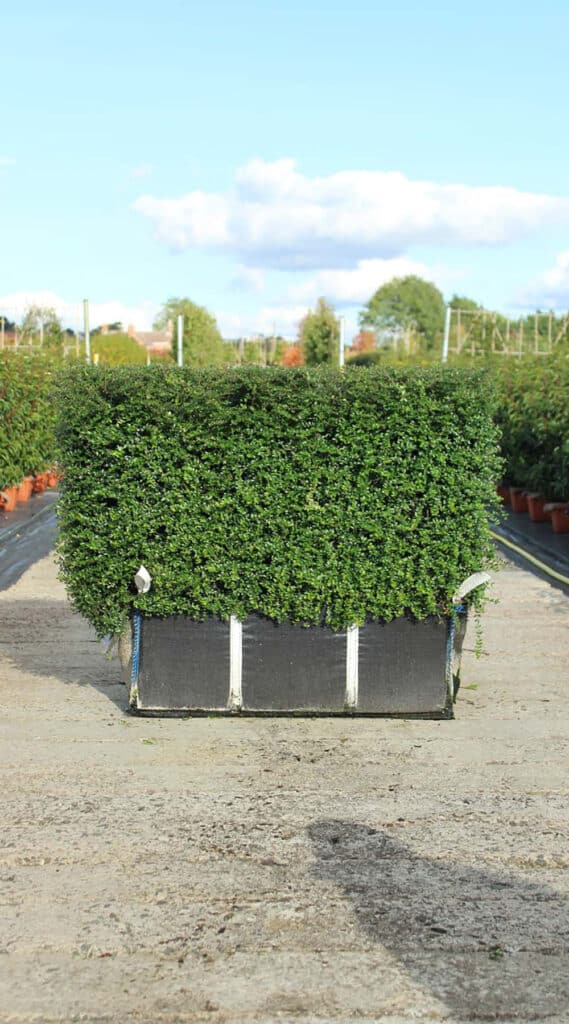
To maintain its desired shape, regular trimming is recommended for the Lonicera nitida hedge. It can be kept around 60 cm tall, making it ideal for low parterre style instant hedges. If allowed to grow taller, up to approximately 150 cm, it is advisable to cut it with a taper to allow light penetration into the base and prevent bare spots. This versatile hedge plant responds well to taper trimming at all heights, ensuring optimal growth and appearance.
Considered a viable alternative to Common Box (Buxus sempervirens), Shrubby Honeysuckle (Lonicera nitida) Instant Hedging stands out with its small leaves, making it an attractive option for creating formal hedges with crisp, sharp edges. It is adaptable to various soil types and can tolerate light shade, offering flexibility in placement within your outdoor space.
While the Shrubby Honeysuckle lacks the large, highly scented flowers found in climbing honeysuckles, it compensates with its ease of maintenance and suitability for all reasonable soils. In its untrimmed state, it produces inconspicuous flowers followed by black berries. This resilient hedging plant thrives in different soil conditions, providing reliable and satisfying results.
b) Hawthorn (Crataegus monogyna) is another excellent hedge option that offers privacy benefits. Also known as thorn, quickthorn, or May, this British native plant has long been used as a field boundary hedge, often interplanted with other species. One of the key features of Hawthorn is its thorny nature, with rigid thorns present on the stems. This makes it an ideal choice for areas where security is a priority. The thorns act as a deterrent, creating a natural barrier that helps to protect your property and maintain privacy.

Depending on your specific needs, Hawthorn can be managed in different ways to enhance its privacy-enhancing qualities. Regular trimming can be employed to encourage thickening, resulting in a dense and attractive garden hedge. However, it’s important to note that frequent trimming may reduce the number of flowers and fruit produced.
Alternatively, Hawthorn can be “laid” using traditional hedging techniques, which involve partially cutting and bending the stems to create a tightly interwoven and secure hedge. This method is particularly effective for achieving a dense and impenetrable barrier, suitable for containing animals or deterring unwanted intruders.
Aside from its privacy benefits, Hawthorn instant hedge is highly adaptable and easy to grow. It thrives in various soil conditions, including very dry or moist soil, making it a versatile option for different garden environments. Furthermore, Hawthorn exhibits excellent tolerance to environmental factors such as coastal exposure and pollution commonly found in industrial or urban areas. By planting Hawthorn hedges, you not only create a private space but also contribute to reducing pollution levels, as the plant helps filter and cleanse the air in its vicinity.
c) Common Laurel (Prunus lau. rotundifolia), also known as Cherry laurel, is a popular choice for creating instant privacy in your garden. This large-leaved evergreen plant grows vigorously and can spread wide if not controlled, reaching heights of around 5 meters. However, when used as a hedge, it can be easily maintained at a more manageable height of 150cm to 200cm. The leaves of the Common Laurel are large, and leathery, and display a glossy dark green colour. This attribute makes it an excellent screening plant, providing a dense barrier that effectively shields your garden from prying eyes. Whether you want to enjoy some peaceful moments or create a secluded outdoor space for relaxation, the Common Laurel hedge offers the privacy you desire.
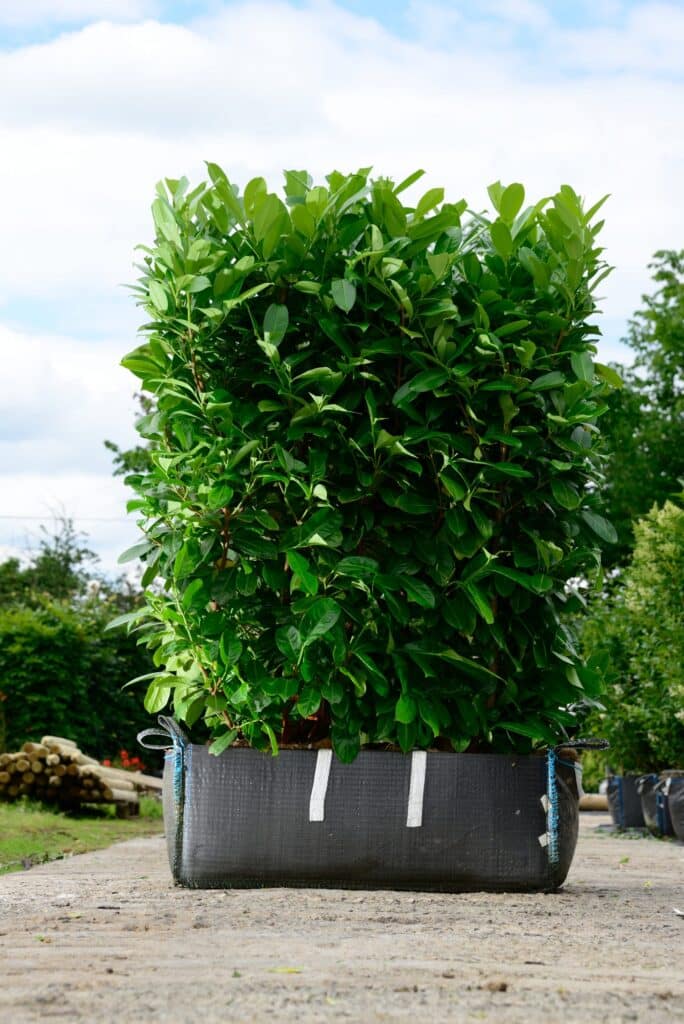
3. Fast-Growing Hedges for Noise Reduction
In addition to providing privacy, fast growing hedges can also act as effective sound barriers. If you live in a noisy neighbourhood or near a busy road, these hedges can help reduce unwanted noise and create a more peaceful environment. Consider the following fast growing hedge options for noise reduction:
a) Privet (Ligustrum): Privet hedges not only offer privacy but also provide excellent noise reduction benefits. With their thick foliage and layered branches, they absorb and deflect sound effectively. Common privet (Ligustrum vulgare) and Japanese privet (Ligustrum japonicum) are popular choices known for their noise-reducing properties.
b) Lonicera nitida hedging: Due to its dense foliage and fast growth rate, lonicera ntida is not only great for privacy but also effective in reducing noise. The thick barrier it creates can help buffer and dampen sounds, creating a quieter and more peaceful outdoor environment.
c) Common Laurel hedge In addition to its privacy benefits, the also boasts impressive noise-cancelling qualities. The foliage of this plant is not only visually appealing but also acts as a soundproofing agent. The large leaves absorb and trap sound, preventing it from reflecting into the surrounding area.
This makes the Common Laurel hedge an ideal choice if you live near a busy road, noisy neighbours, or any other source of unwanted sound. By planting this hedge, you can create a more serene and peaceful environment within your garden, allowing you to unwind and enjoy moments of tranquillity. So, not only does the Common Laurel hedge offer privacy, but it also helps to reduce noise pollution, providing you with a more enjoyable outdoor space.
4. Choosing the Right Fast Growing Hedges
With numerous options available, it’s essential to choose the right hedges for your specific needs and garden conditions. Consider the following factors when selecting your hedges:
- Purpose: Determine the primary purpose of your hedge. Are you looking for privacy, noise reduction, windbreaks, or simply enhancing the beauty of your garden? Clarifying your goals will help you make informed decisions about the hedge varieties that best align with your needs.
- Garden Conditions: Assess your garden’s environmental conditions, including sunlight exposure, soil type, and climate. Some hedges thrive in full sun, while others can tolerate shade. Similarly, certain varieties prefer well-draining soil, while others can adapt to various soil types. By understanding your garden’s conditions, you can select hedges that are well-suited to thrive in your specific environment.
- Growth Rate: Consider the growth rate of the hedge species you’re interested in. Some varieties can grow several feet per year, while others have a more moderate growth rate. If you’re looking for rapid results, opt for faster-growing species. However, keep in mind that fast growing hedges may require more frequent maintenance to keep them in check.
- Maintenance Requirements: Different hedge species have varying maintenance needs. Some may require regular pruning, shaping, or pest control, while others are relatively low-maintenance. Assess your ability and willingness to devote time and effort to hedge maintenance to ensure you choose varieties that align with your preferences.
- Aesthetics: Lastly, consider the visual appeal of the hedge species you’re considering. Look for hedges with foliage colours and textures that complement your garden design and overall aesthetic. Whether you prefer lush green foliage, flowering hedges, or a mix of different textures, there’s a fast growing hedge that will meet your aesthetic preferences.
5. Planting and Care Tips
Once you’ve selected the right hedges for your garden, it’s important to provide proper care to ensure optimal growth and long-term health. Follow these tips to help your hedges thrive:
- Site Selection: Choose a location that provides adequate sunlight for the specific hedge species you’ve selected. Most hedges prefer full sun to partial shade conditions. Additionally, ensure the soil has good drainage to prevent waterlogging, as excessive moisture can harm the roots.
- Soil Preparation: Prepare the soil before planting your hedges. Remove weeds, rocks, and debris and amend the soil with organic matter to improve its structure, drainage, and nutrient content. This will create an optimal growing environment for your hedges.
- Proper Planting Techniques: Dig a trench or individual holes to accommodate the root balls of your hedge plants. Place the plants at the appropriate spacing recommended for the selected species. Backfill the holes with soil, ensuring the roots are properly covered, and gently firm the soil around the base of each plant.
- Watering: Newly planted hedges require regular watering to establish their root systems. Water deeply and thoroughly, ensuring the entire root zone is adequately moistened. Monitor the moisture level of the soil and adjust the watering frequency as needed, taking into account rainfall and weather conditions.
- Mulching: Apply a layer of organic mulch around the base of your hedges, leaving a small gap around the stems to prevent moisture-related issues. Mulch helps conserve soil moisture, suppress weed growth, and regulate soil temperature.
- Pruning and Maintenance: Fast growing hedges often benefit from regular pruning to maintain their desired shape, density, and height. Prune your hedges during the appropriate times of the year, following specific guidelines for each species. Regularly monitor for pests, diseases, and nutrient deficiencies, and take appropriate measures to address any issues that arise.
- Feeding: Provide your hedges with the necessary nutrients for healthy growth. Apply a balanced, slow-release fertiliser formulated for shrubs and hedges according to the manufacturer’s instructions. Additionally, consider conducting a soil test to identify any nutrient deficiencies and adjust your fertiliser application accordingly.
Conclusion
Fast-growing hedges have the power to transform your outdoor space, offering privacy, beauty, and environmental benefits. By selecting the right hedge varieties, planting them correctly, and providing proper care, you can enjoy a lush and vibrant garden in no time.
At Readyhedge, we are dedicated to providing quality instant hedging and screening solutions. Our extensive stock list offers a wide range of fast-growing hedge varieties suitable for all garden types. Whether you’re looking for privacy hedges, noise-reducing hedges, or simply want to enhance the beauty of your outdoor space, we have the perfect options for you.
Browse our stocklist to explore the full range of fast-growing hedges we offer. Each variety is accompanied by detailed information on ideal planting conditions, growth habits, and maintenance requirements. Our knowledgeable team is always ready to provide advice and guidance to help you make the best choices for your garden.
Transform your outdoor space with fast-growing hedges. Experience the joy of a lush and beautiful garden while enjoying the benefits of privacy, noise reduction, and environmental enhancement. Contact Readyhedge today at 01386 750 585 or visit our website to explore our stocklist and start your hedge transformation journey.
FAQ
1. What is the fastest growing hedge for privacy? The Leylandii (Cupressocyparis leylandii) is known as one of the fastest growing hedges for privacy. It can grow up to 3 feet per year, providing a dense and tall barrier for privacy.
2. What shrub grows the fastest? The Privet (Ligustrum) shrub is renowned for its fast growth rate. It is a versatile and hardy shrub that can grow at a rapid pace, making it an excellent choice for creating hedges or screening.
3. What is the fastest growing evergreen hedge tree? The Western Red Cedar (Thuja plicata) is considered one of the fastest growing evergreen hedge trees. It has an impressive growth rate and can reach considerable heights, providing year-round privacy and greenery.
4. What is the best shrub for a privacy fence? The Laurel (Prunus laurocerasus) shrub is often regarded as an ideal choice for a privacy fence. It grows quickly and forms a thick, lush foliage that offers excellent screening and privacy.
5. What is the fastest growing hedge in the UK? The English Yew (Taxus baccata) is known for its relatively fast growth rate among native UK hedges. While it may not grow as rapidly as some other species, it offers longevity, dense foliage, and a classic aesthetic appeal.
Please note that the growth rate may vary depending on factors such as climate, soil conditions, and maintenance practices. It’s advisable to consult with a horticulturist or nursery specialist to determine the best options for your specific location and requirements.















